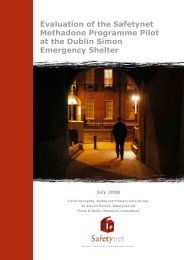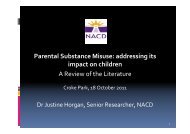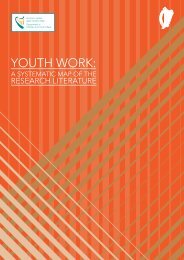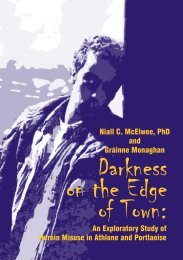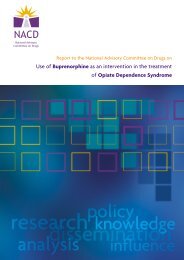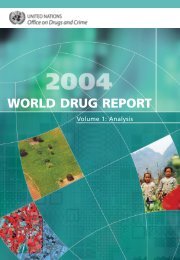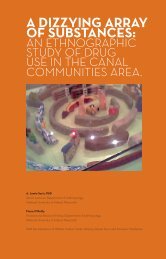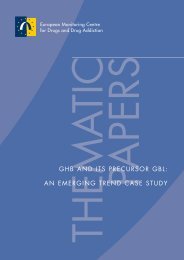Crack cocaine in the Dublin region - Health Research Board
Crack cocaine in the Dublin region - Health Research Board
Crack cocaine in the Dublin region - Health Research Board
Create successful ePaper yourself
Turn your PDF publications into a flip-book with our unique Google optimized e-Paper software.
Ten <strong>in</strong>terviews were conducted with current or former crack users. A number of <strong>the</strong>separticipants were recruited through drug-treatment and social services. A purposivesampl<strong>in</strong>g procedure was used to recruit participants. 8 In light of <strong>the</strong> fact that crackusers may not access treatment or social services, <strong>the</strong> research team also used asnowball sampl<strong>in</strong>g procedure to recruit participants outside drug-treatment and socialservices. This <strong>in</strong>volved us<strong>in</strong>g respondents identified through treatment services to assist<strong>in</strong> recruit<strong>in</strong>g o<strong>the</strong>r crack users known to <strong>the</strong>m who were not <strong>in</strong> treatment.The <strong>in</strong>terviews and focus groups were audio-taped and transcribed verbatim. Thetranscribed data was entered <strong>in</strong>to NVivo (qualitative data analysis software) andanalysed us<strong>in</strong>g a cod<strong>in</strong>g scheme based on <strong>the</strong> <strong>in</strong>terview guide. 9 Key <strong>the</strong>mes <strong>in</strong> each<strong>in</strong>terview and focus group were identified and categorised accord<strong>in</strong>g to <strong>the</strong>ir code and<strong>the</strong> similarities and differences with<strong>in</strong> <strong>the</strong>se key <strong>the</strong>mes were exam<strong>in</strong>ed.Drug-treatment dataThe National Drug Treatment Report<strong>in</strong>g System (NDTRS) is an epidemiological databaseon treated problem drug and alcohol use <strong>in</strong> Ireland.Drug-treatment data are viewed as an <strong>in</strong>direct <strong>in</strong>dicator of drug and alcohol misuseas well as a direct <strong>in</strong>dicator of demand for treatment services. NDTRS data are usedat both a national (alcohol and drug data) and European level (drug data) to provide<strong>in</strong>formation on <strong>the</strong> characteristics of clients enter<strong>in</strong>g treatment, and on patterns ofsubstance misuse, such as types of substance used and consumption behaviours.For <strong>the</strong> purpose of <strong>the</strong> NDTRS, treatment is broadly def<strong>in</strong>ed as ‘any activity which aimsto alleviate <strong>the</strong> psychological, medical or social state of <strong>in</strong>dividuals who seek help for<strong>the</strong>ir substance misuse problems’. Drug-treatment options <strong>in</strong>clude one or more of <strong>the</strong>follow<strong>in</strong>g: medication (detoxification, methadone reduction, substitution programmesand psychiatric treatment); brief <strong>in</strong>tervention; counsell<strong>in</strong>g; group <strong>the</strong>rapy; family<strong>the</strong>rapy; psycho<strong>the</strong>rapy; complementary <strong>the</strong>rapy; and/or life skills tra<strong>in</strong><strong>in</strong>g.Compliance with <strong>the</strong> NDTRS requires that one form be completed for each new clientcom<strong>in</strong>g for first treatment and for each previously treated client return<strong>in</strong>g to treatmentfor problem substance use. Service providers at treatment centres throughout Irelandcollect data on each <strong>in</strong>dividual who attends for first treatment or returns to treatmentbetween 1 January and 31 December each year.8 Us<strong>in</strong>g a purposive sampl<strong>in</strong>g procedure, respondents are chosen because <strong>the</strong>y have particular features orcharacteristics which will enable detailed exploration of <strong>the</strong> research objectives (Robson 2002).9 Nvivo is software that facilities <strong>the</strong> analysis of qualitative data (e.g. <strong>in</strong>-depth <strong>in</strong>terviews, field notes, focusgroups etc.) <strong>in</strong> a systematic fashion.<strong>Crack</strong> <strong>coca<strong>in</strong>e</strong> <strong>in</strong> <strong>the</strong> Dubl<strong>in</strong> <strong>region</strong>: an evidence base for a crack <strong>coca<strong>in</strong>e</strong> strategy27




